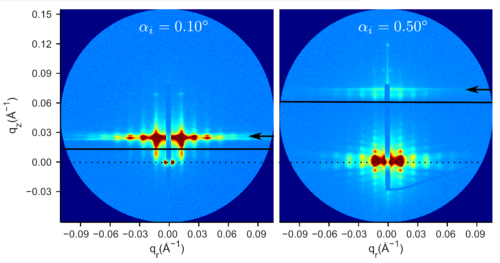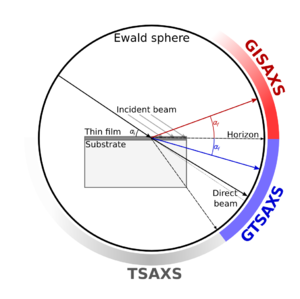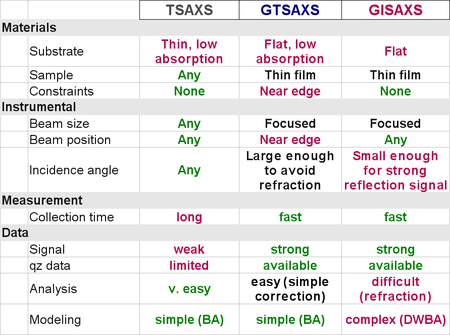Difference between revisions of "GTSAXS"
KevinYager (talk | contribs) (Created page with "'''GTSAXS''', or '''Grazing-incidence Transmission Small-Angle X-ray Scattering''' is a variant of GISAXS; i.e. it is a surface-sensitive x-ray scattering technique. I...") |
KevinYager (talk | contribs) |
||
| Line 1: | Line 1: | ||
| − | '''GTSAXS''', or '''Grazing-incidence Transmission Small-Angle X-ray Scattering''' is a variant of [[GISAXS]]; i.e. it is a surface-sensitive x-ray [[scattering]] technique. In GTSAXS, the x-ray beam is directed towards the ''edge'' of a sample (rather than the center). This small geometric difference allows the sub-horizon scattering (which is normally attenuated due to substrate [[absorption]]) to escape from the sample edge, and be recorded. This sub-horizon scattering is 'cleaner' than conventional GISAXS data. In particular, it suffers much less from the [[refraction]]-induced [[refraction distortion|distortion]] of [[reciprocal-space]] and the [[dynamic scattering|multiple scattering]] effects that plague conventional GISAXS. | + | '''GTSAXS''', or '''Grazing-incidence Transmission Small-Angle X-ray Scattering''' is a variant of [[GISAXS]]; i.e. it is a surface-sensitive [[x-ray]] [[scattering]] technique. In GTSAXS, the x-ray beam is directed towards the ''edge'' of a sample (rather than the center). This small geometric difference allows the sub-horizon scattering (which is normally attenuated due to substrate [[absorption]]) to escape from the sample edge, and be recorded. This sub-horizon scattering is 'cleaner' than conventional GISAXS data. In particular, it suffers much less from the [[refraction]]-induced [[refraction distortion|distortion]] of [[reciprocal-space]] and the [[dynamic scattering|multiple scattering]] effects that plague conventional GISAXS. |
| + | |||
| + | [[Image:Fig-TGSAXS-regimes04-simpler.png|300px|thumb|center|Geometry of a GTSAXS experiment. In the GTSAXS geometry, the x-ray beam is directed towards the edge of the substrate, so that the direct beam and nearby small-angle scattering can escape without being absorbed by the substrate.]] | ||
| + | |||
| + | [[Image:GTSAXS example data.png|thumb|500px|center|Example of [[GISAXS]] data (left) and GTSAXS data (right) for a 'fingerprint' pattern (vertical [[block-copolymer|BCP]] lamellae). The higher incidence angle of GTSAXS moves the refraction-distortion (and the [[Yoneda]]) away from the data. The GTSAXS data is much 'cleaner', as it is not distorted and does not exhibit the 'peak splitting' that arises from multiple-scattering.]] | ||
| + | |||
| + | ==Comparison== | ||
| + | GTSAXS can be thought of as a combination of a transmission-scattering ([[TSAXS]]) and grazing-incidence ([[GISAXS]]). In some sense, it combines the simple of data analysis of TSAXS with the surface-sensitive probing of GISAXS. | ||
| + | |||
| + | [[Image:GTSAXS comparison table01.png|450px|center]] | ||
| + | |||
| + | The main disadvantage of GTSAXS is sample preparation: the material of interest must be near the ''edge'' of the substrate. Standard film preparation methods may not yield a representative material near edges. For instance, spin-coating frequently leads to material build-up near substrate edges; this thicker region will dominate the GTSAXS signal, and not be representative of the thin-film structure in the center of the substrate. This can be easily overcome by cleaving substrates, so as to expose a representative edge for probing. | ||
==References== | ==References== | ||
Revision as of 10:14, 1 December 2014
GTSAXS, or Grazing-incidence Transmission Small-Angle X-ray Scattering is a variant of GISAXS; i.e. it is a surface-sensitive x-ray scattering technique. In GTSAXS, the x-ray beam is directed towards the edge of a sample (rather than the center). This small geometric difference allows the sub-horizon scattering (which is normally attenuated due to substrate absorption) to escape from the sample edge, and be recorded. This sub-horizon scattering is 'cleaner' than conventional GISAXS data. In particular, it suffers much less from the refraction-induced distortion of reciprocal-space and the multiple scattering effects that plague conventional GISAXS.

Comparison
GTSAXS can be thought of as a combination of a transmission-scattering (TSAXS) and grazing-incidence (GISAXS). In some sense, it combines the simple of data analysis of TSAXS with the surface-sensitive probing of GISAXS.
The main disadvantage of GTSAXS is sample preparation: the material of interest must be near the edge of the substrate. Standard film preparation methods may not yield a representative material near edges. For instance, spin-coating frequently leads to material build-up near substrate edges; this thicker region will dominate the GTSAXS signal, and not be representative of the thin-film structure in the center of the substrate. This can be easily overcome by cleaving substrates, so as to expose a representative edge for probing.
References
- Lu, X.; Yager, K.G.; Johnston, D.; Black, C.T.; Ocko, B.M. Grazing-incidence transmission X-ray scattering: surface scattering in the Born approximation Journal of Applied Crystallography 2013, 46, 165–172. doi: 10.1107/S0021889812047887
- Mahadevapuram, N.; Strzalka, J.; Stein, G.E. Grazing-incidence transmission small angle X-ray scattering from thin films of block copolymers J. Polymer Sci. Part B Polymer Phys. 2013 51, 602610. doi: 10.1002/polb.23261
- Weidman, M.C.; Yager, K.G., Tisdale, W.A. Interparticle Spacing and Structural Ordering in Superlattice PbS Nanocrystal Solids Undergoing Ligand Exchange Chemistry of Materials 2015 doi: 10.1021/cm503626s

